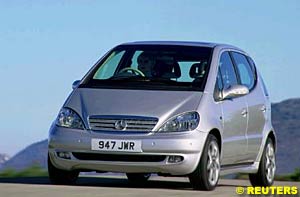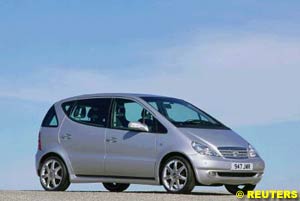

Automotive News and Reviews for the Petrolhead
Reuters Motoring Commentator
In this week's issue:
- First isn't Always Best
- Size Matters
Mercedes-Benz has achieved some commendable 'firsts' with the one-box A-class since its introduction in October 1997. It was the marque's first front wheel drive hatchback. It was the first to use 'sandwich' construction, with the engine and gearbox sandwiched between two floor pans. It has also won a lot of conquest sales. No less than 85 percent of A-class customers in the UK are first-time Mercedes customers.
Some of the other 'firsts' have been less welcome. The launch of the A-class was marred by its failure in the now-infamous 'elk test'. When Scandinavian journalists swerved around an object representing a wandering elk, the A-class toppled over. No sooner had the engineers made the necessary adjustments to make the new car elk-proof than the production department faced claims of another 'first': The A-class was the first Mercedes to face charges of poor build quality.
Great Concept. Lousy Execution
The principle of building 'hot' versions of humdrum cars is well established. Cars like the Ford Focus RS, Honda Civic Type R, Mitsubishi Lancer EVO VIII and Subaru Impreza STi demonstrate the fantastic potential of the concept. The idea isn't new to Mercedes either. Having won its spurs as a hot car producer twenty years ago with the bespoilered 190E Cosworth, Mercedes has gone on to produce an impressive stable of sports derivatives wearing the badge of AMG, the corporation's highly respected tuning division. There are now AMG versions of every car and offroader in the range - except the A-class.
Internal politics, one suspects, prevented AMG from lending their name to the A210. They compromised by developing a body-styling kit for all models of the A-class, but could clearly see that the chassis was desperately unsuited to high performance. But the marketing department was equally determined, and - either out of spite or as a misplaced joke - decided to name their 'hot' A-class the A210 Evolution. On paper, the A210 Evo concept looks promising. Take either the short or long wheelbase version of the A-class. Clothe it in AMG body kit. Fit a specially developed 2.1-litre engine with 37 percent more torque and 87 percent more power. Pile on all the extras from the specification list and plant it on huge seven-spoke alloy wheels with paper-thin low profile tyres.
Shattered Illusions
In terms of visual appeal, the A210 is a winner. Purposeful, squat and muscular, it is easily the most attractive A-class. But - like a dinner date with a page 3 girl - its appeal is short-lived. The engine provides more than enough power. Quite literally. Accelerate hard and two failings rise to the fore. Firstly, the noise is intrusive, with a tinny rattling from the exhaust. Secondly - and more worryingly - it is clear that Mercedes have yet to master the art of putting power to the road through the front wheels.
By the time you have reached motorway cruising speeds the drama is over - but another battle is inevitable if you have passengers in the spacious rear seats. Within five miles the complaints will start. Road noise from the low profile tyres combine with poor soundproofing of the coarse 4-cylinder engine to make conversation difficult and long distance travel distinctly uncomfortable.
From Bad to Worse
Matters get even worse on more demanding roads. The sports suspension keeps body roll down to acceptable levels, but the way the body pitches fore and aft with every gear change quickly becomes tiresome. The loud impact when the low profile tyres hit any hole in the road surface is alarming, but the shock is minor compared with the A210's struggle for composure when it comes over a hump or crest. AMG's refusal to lend its name to the sporty A-class is totally justified. Like a granny on a quad-bike, the A210 simply cannot handle the power.
The range-topping A-class doesn't even redeem itself in the luxury stakes. Its specification list might include some cosmetic plus points like a silver grille, chrome sill strips and a silver coloured dials in an over-styled instrument display. Four electric windows, a height-adjustable driver's seat and seats trimmed in a leather / alcantara combination are respectable too. But the longer you spend with the A210, the more apparent the shortcomings become. The steering column adjusts for height, for example, but not for reach. There is only a lap belt for the centre seat in the rear. The A210 is only equipped with air-conditioning, not climate control, and the single CD player is an optional extra. Adding a 6-disc CD changer and a respectable sound system adds almost another £1000 to the already steep price.
The A-class Mercedes has been a success - and deservedly so. It is spacious, pleasant to drive, practical to use, holds its value well and carries the prestige of the three-pointed star. But the overpriced A210 Evolution model tries to take the range into the realms of performance motoring - and fails dismally.
Written by David Summer Smith
When it comes to the business of driving quickly, but legally, on the road it's best you leave the Porsche in the garage. What you really need, particularly in and around town, is something small, underpowered and sweet handling. Ignoring the fact that he was also broke and couldn't afford to put petrol in it, why else did former World Motor Racing Champion, James Hunt, leave his Mercedes at home, on bricks, choosing instead to terrorise the streets of south west London in an old Austin van?
I have no wish to cause offence here, but it is true to say that most high-powered performance cars don't end up in the hands of the likes of James Hunt, but instead are purchased by people who couldn't drive sheep. And those that don't cannot be used to their full potential on the road because the laws of the land don't permit it. As desirable as a supercar may be, it is often the motoring equivalent of being all dressed-up with nowhere to go. All that power, all that speed but a Post Office van will scythe through the traffic quicker.
A Car Full of Surprises
This is the convertible version of Smart's original (hardtop) City Coupe and in its base trim is actually the cheapest new convertible you can buy in Britain. The tiny roof is simple but cleverly done, sliding all the way back at the push of a button with detachable side-bars that can be conveniently stowed in a compartment in the boot. The boot itself is naturally quite small, but not hopelessly so, and certainly provides a useable amount of space for the type of journey the Smart was designed for.
So it's striking, spacious and gets you noticed, what else do you need from a car? How about a turbo-charged, rear-mounted engine driving the rear wheels through a sequential semi-automatic six-speed gearbox? Remarkably, this is exactly what you get. It may only produce 61 BHP from its pocket-sized 698cc, three-cylinder engine but the Smart Cabrio is also lighter than a properly cooked souffle. Even so, something with such a paucity of punch has a set of performance figures that would be embarrassing to discuss in company (15.5 seconds to reach 62 MPH / 84 MPH top speed) but at just over 60 miles to the gallon (combined figure) you'll happily holler from the rooftops about the fuel consumption.
Fast Feeling
The Smart was conceived as a practical and stylish means of dashing about town, where convenience and economy are twice as valuable as top speed. But actual facts are not what this car is about. The beauty of the Smart, and we are back to the issue of perception again here, is that it always feels fast. It revs eagerly through to the red line in every gear and the Soft Touch sequential gearbox is a hoot. I am utterly convinced that nothing on the road reaches 10 MPH quicker than this car. The sensation of speed and fun is brilliantly exaggerated by the wonderful, rasping exhaust note, releasing endorphins in the brain that compel you to urge the Smart to the very limit of its capabilities. Steering, handling and road-holding are all decent enough and every model comes equipped with a full complement of electronic braking and stability aids. Nevertheless, with the engine in the back and just your feet out front, most of the weight is at the rear. There is nowhere near enough power to encounter unwarranted over-steer but any rushes of blood through the bendy bits will provoke the ultra-light front end to merrily under-steer into tomorrow.
No Bargain
Accept the Smart Cabrio for what it is and any real criticism is minimal. The driver's seat is set too high, a consequence of which is a steering wheel that feels as if it is sat in your lap while at a cough and a whistle under £10,000 for this particular model, it is arguably no bargain. The entry-level Pure model is £1,200 cheaper and still offers the same fun, style and clever sense of purpose, but then it is another Smart misunderstanding to assume that a lack of external dimensions should equate to a bargain-basement price. When considered from an engineering, styling and specification point of view, you might argue that a Smart is actually a very inexpensive Mercedes-Benz.
Inevitably, the Smart City Coupe/Cabrio will not suit everyone's purpose, but then no car ever can. Some people will always need more than two seats; others will want more power for long motorway journeys and these drivers may well choose to look elsewhere. But what about the friend of mine who thinks the Cabrio is a work of genius yet can't shake off the feeling that it looks like an upholstered dustbin (his words, not mine)? Salvation is but a month away. At the beginning of September, Smart launches two new models, the Smart Roadster and the Smart Roadster Coupe. They still offer the same real-world, no-nonsense dynamics of the Cabrio and City Coupe, but they've also been styled to tickle the fancy of the ultra cool and trendy. You can read more about this model next month, but expect the Smart Roadster to become one of the most sought-after London lifestyle accessories of next year.
Meanwhile I feel certain that if he were still around today, James Hunt would have been perfectly happy tearing about town in a Cabrio. It would have suited his concerted disregard for convention and appealed to his sense of mischief. And if it's good enough for James Hunt, it's good enough for me!
![]() First isn't Always Best
First isn't Always Best
 All that seems long ago. More than 963,000 examples of the A-class have been sold around the world, including almost 70,000 in the UK. The record of sales success was enhanced by the addition of an extended wheelbase version. By adding another 170mm to the body length, Mercedes created a compact family car with more legroom than the plutocrats' S-class luxury saloon. But now the A-class has scored another first. It is the first model range in living memory where the top model is unquestionably the worst car in the entire set. The premium-priced A210 is an utter disaster - and laughably poor value compared with more modest versions.
All that seems long ago. More than 963,000 examples of the A-class have been sold around the world, including almost 70,000 in the UK. The record of sales success was enhanced by the addition of an extended wheelbase version. By adding another 170mm to the body length, Mercedes created a compact family car with more legroom than the plutocrats' S-class luxury saloon. But now the A-class has scored another first. It is the first model range in living memory where the top model is unquestionably the worst car in the entire set. The premium-priced A210 is an utter disaster - and laughably poor value compared with more modest versions.
 The front end rises as the A210 moves away and the steering starts an ongoing battle with the transmission. Problems with torque steer are predictable enough in really powerful front wheel drive cars like the 220bhp Focus RS and the 250bhp Alfa 147 GTA. But the fight involved in applying 'just' 140bhp to the road while maintaining a straight line sets the alarm bells ringing?
The front end rises as the A210 moves away and the steering starts an ongoing battle with the transmission. Problems with torque steer are predictable enough in really powerful front wheel drive cars like the 220bhp Focus RS and the 250bhp Alfa 147 GTA. But the fight involved in applying 'just' 140bhp to the road while maintaining a straight line sets the alarm bells ringing?
![]() Size Matters
Size Matters
 Which is why you need a Smart Cabrio. At first glance it looks like the funkiest little invalid carriage you've ever seen but there is little to suggest it could quicken your pulse. Yet nothing could be further from the truth. The Smart Cabrio is apt demonstration that judgment based purely on perception can be a major mistake and is a car full of surprises. The biggest comes once you open the door because the Cabrio has the sort of legroom that simply isn't found in cars twice its size. With no rear seats or passengers to accommodate, the designers have managed to make maximum use of the teardrop pod shape and it is a very cleverly packaged car. The legroom is matched by ample headroom and although it is very narrow (a full 18 cm slimmer than a MINI, for example), it never feels cramped.
Which is why you need a Smart Cabrio. At first glance it looks like the funkiest little invalid carriage you've ever seen but there is little to suggest it could quicken your pulse. Yet nothing could be further from the truth. The Smart Cabrio is apt demonstration that judgment based purely on perception can be a major mistake and is a car full of surprises. The biggest comes once you open the door because the Cabrio has the sort of legroom that simply isn't found in cars twice its size. With no rear seats or passengers to accommodate, the designers have managed to make maximum use of the teardrop pod shape and it is a very cleverly packaged car. The legroom is matched by ample headroom and although it is very narrow (a full 18 cm slimmer than a MINI, for example), it never feels cramped.
 The biggest error of judgment one could make about the Smart is to assume its diddy dimensions conceal something quite basic inside. In addition to the clever design and engineering, you also get a very comfortable and funky interior. Twin airbags, air conditioning, a decent-sounding CD player and electric windows are all standard fit on the Passion model I drove. The cabin has been designed with one eye on functional ergonomics and the other on putting it together with flair. There are some pleasingly quirky design touches (the Magic Roundabout-style tacho and clock on stalks, for example) but everything works efficiently and feels nicely screwed together for a car in this sector. It is probably only to be expected, as Smart is part of the Daimler Chrysler group, ultimate parent of the estimable Mercedes-Benz.
The biggest error of judgment one could make about the Smart is to assume its diddy dimensions conceal something quite basic inside. In addition to the clever design and engineering, you also get a very comfortable and funky interior. Twin airbags, air conditioning, a decent-sounding CD player and electric windows are all standard fit on the Passion model I drove. The cabin has been designed with one eye on functional ergonomics and the other on putting it together with flair. There are some pleasingly quirky design touches (the Magic Roundabout-style tacho and clock on stalks, for example) but everything works efficiently and feels nicely screwed together for a car in this sector. It is probably only to be expected, as Smart is part of the Daimler Chrysler group, ultimate parent of the estimable Mercedes-Benz.
© 2007 autosport.com . This service is provided under the Atlas F1 terms and conditions.
|
Volume 9, Issue 33
Articles
The Next Generation
Forgotten in the Forest
Columns
Rear View Mirror
On the Road
Elsewhere in Racing
The Weekly Grapevine
> Homepage |